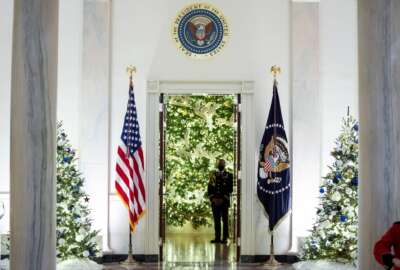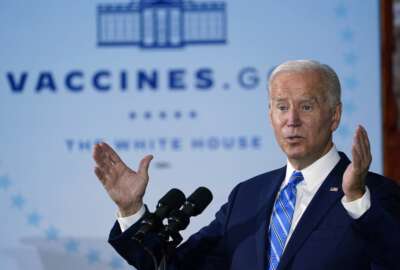
OMB sets workforce, customer experience targets for agency teams carrying out PMA goals
The Biden administration is putting its management vision for the federal government into greater focus.
The Biden administration is putting its management vision for the federal government into greater focus.
The Office of Management and Budget is working with several interagency teams as part of the President’s Management Agenda to set targets for agencies to empower the federal workforce and deliver a higher standard of customer service to the public.
OMB and agencies are also looking to use their collective purchasing power to ensure that a greater share of federal contracting dollars go to small, disadvantaged businesses and empower the government’s financial management workforce.
OMB, in a major update to Performance.gov on Thursday, outlined a sweeping set of goals agencies should meet under the PMA, as well as metrics they’ll use to track progress.
OMB is also releasing the names of strategy leads who will ensure the PMA priorities have the “sustained attention they deserve and the focus and expertise of subject-matter experts who drive day-to-day implementation.”
More effective hiring, with focus on diversity and retention
Among its goals, the PMA’s workforce team is looking to increase the number of federal interns that are converted into full-time employees, increase the number of paid internships across government, and increase the number of positions agencies make available for early career hires.
Agencies are also expected to increase administrative retention incentives and pay flexibilities for top agency mission-critical occupations.
The team is led by Office of Personnel Management Director Kiran Ahuja, Deputy Defense Secretary Kathleen Hicks and Deputy Labor Secretary Julie Su.
The team is also focused on addressing barriers in the federal hiring process. Agencies plan to increase the number of hiring actions that rely on alternative skills assessments, rather than rely on candidates self-reporting their qualifications.
A growing number of agencies, for example, are using Subject Matter Expert Qualification Assessments to hire employees with specialized skills, such as data scientists or customer experience experts.
OPM and OMB launched a SME-QA community of practice earlier this year, bringing together all the agencies that have launched SME-QA pilots.
Agencies will also review applicant data to flag hurdles that prevent a more diverse pool of applicants from making it through the hiring process, as well as increase the number of job announcements that give applicants notification of their status in the hiring process.
Agencies are also directed to make their workplaces more inclusive by increasing the number of Senior Executive Service employees or other leadership positions that have diversity, equity, inclusion and accessibility goals in their individual performance goals.
The federal workforce team also directs agencies to “use what they have learned about the resilience and adaptability of the federal workforce” to modernize the federal workplace and prepare for the future of work
“As federal agencies continue to chart a path forward together on the future of federal work, they will engage with public servants as well as stakeholders within and outside of government to make every federal job a good job and give our workforce what they need to succeed,” the update said.
President Joe Biden expects the “vast majority” of federal employees to return to the office by the end of this month. However, many agencies are seeking to build a “hybrid workplace” as part of their office reentry plans, meaning agency employees will be routinely permitted to use telework or remote work.
In terms of targets, the workforce team is looking to improve Federal Employee Viewpoint Survey (FEVS) scores, specifically by narrowing agency-identified gaps in employee engagement by employee group or organizational unit by 20%.
The governmentwide FEVS employee engagement increased from 68% in 2019 to 72% in 2020.
The team already sees the data trending in the right direction. FEVS data from 2020 shows that federal employees were more likely to agree that their leadership was more effective, that their work had meaning and that they had the opportunity to grow and learn on the job.
Higher scores for government services
The team behind the customer experience is looking to move from last place to the top 10 of Forrester’s customer experience index.
Most agencies are trending in the right direction. Last year’s federal customer experience metrics from Forrester showed the highest overall scores since the company started tracking these metrics in 2015.
Among 13 industries studied, the federal government ranks last, and the majority of federal customers told Forrester the customer experience they received was “poor” or “very poor.”
Utilities, airlines and health insurers are all ranked higher under the index.
The customer experience team is directing the more than 30 agencies and programs designated as High-Impact Service Providers to publicly report metrics related to public trust and satisfaction with services to Performance.gov starting in 2024.
Agencies are also focused on improving customer “life experiences” that draw on the services of multiple agencies. More than 10 agencies have formed interagency teams to improve the public’s experience during important moments in people’s lives.
The customer experience team is led by Deputy Veterans Affairs Secretary Donald Remy, General Services Administration Administrator Robin Carnahan and Deputy Secretary of the Agriculture Department Jewel Bronaugh.
Improving the business of government
A third team, focused on the “business of government,” is looking to use the federal government’s collective purchasing power to accelerate developments in sustainable technology, as well as support small, disadvantaged businesses.
Federal agencies are now working together to advance equity in procurement practices, including the administration’s goal of making sure contract awards to small, disadvantaged businesses make up 15% of federal contract spending by fiscal 2025.
The business of government team is also assessing the current capacity of the financial assistance workforce to ensure it has the guidance and training required to develop and administer grant programs equitably and efficiently.
The team is directing agencies to build on the lessons learned administering trillions of dollars during the COVID-19 pandemic, as well as ongoing infrastructure spending, to improve the way it issues grants and other forms of federal financial assistance.
Pandemic spending, and oversight into improper payments, offered lessons-learned in program payment and integrity.
“Now is an opportune time to break down silos and focus on managing the business of government as a federal enterprise to ensure that system-wide, continuous improvement occurs,” the team wrote.
In FY 2021, agencies spent over $630 billion through contracts for goods and services with over 120,000 business entities, supported by nearly 40,000 federal contracting officers.
The business of government team is led by Deputy Commerce Secretary Don Graves, Deputy Secretary of Health and Human Services Andrea Palm and Deputy Secretary of Homeland Security John Tien.
Copyright © 2024 Federal News Network. All rights reserved. This website is not intended for users located within the European Economic Area.
Jory Heckman is a reporter at Federal News Network covering U.S. Postal Service, IRS, big data and technology issues.
Follow @jheckmanWFED
Related Stories

Biden administration details initial vision, three top priorities under President’s Management Agenda




